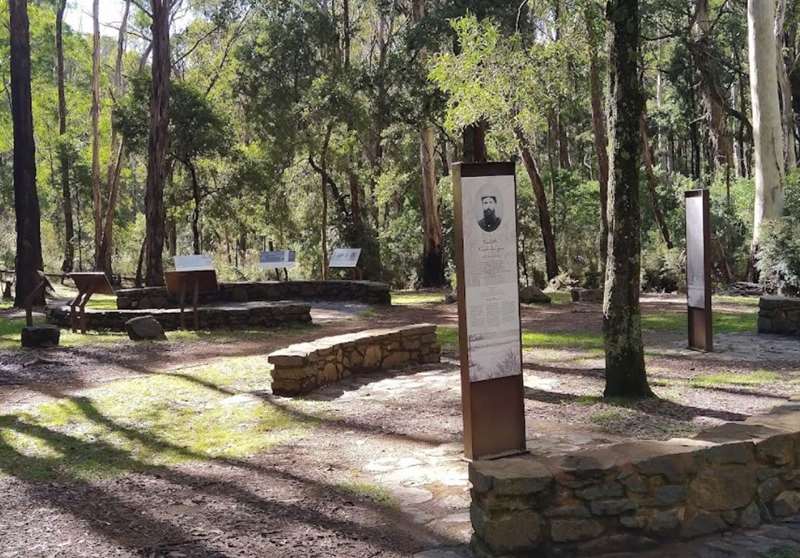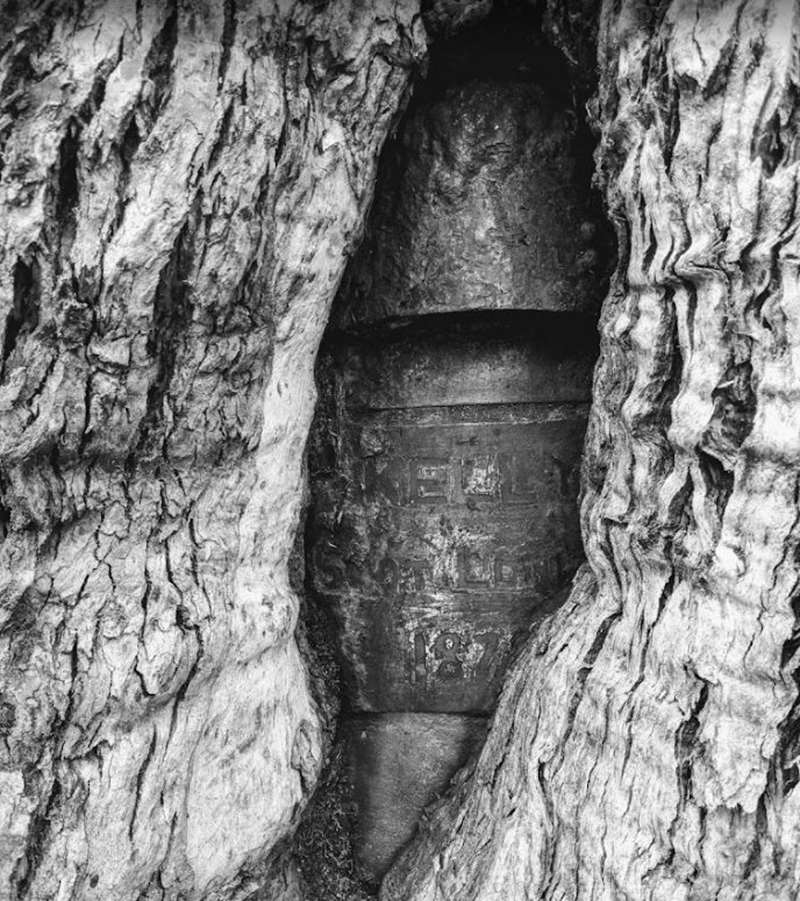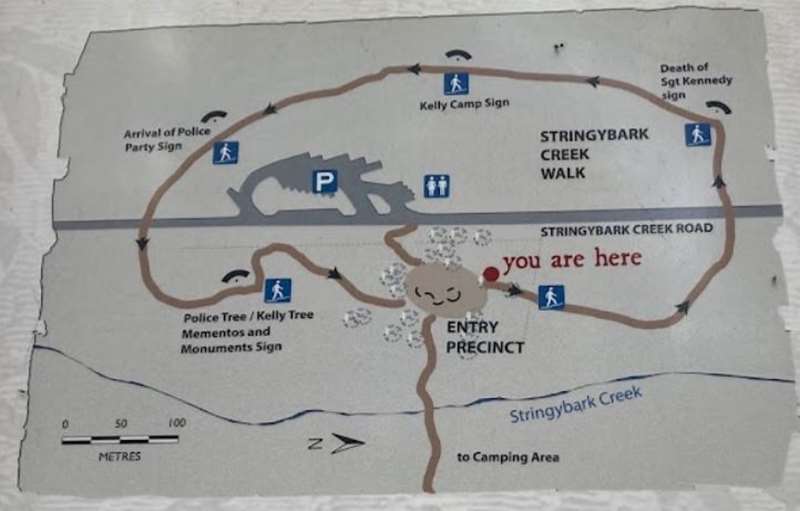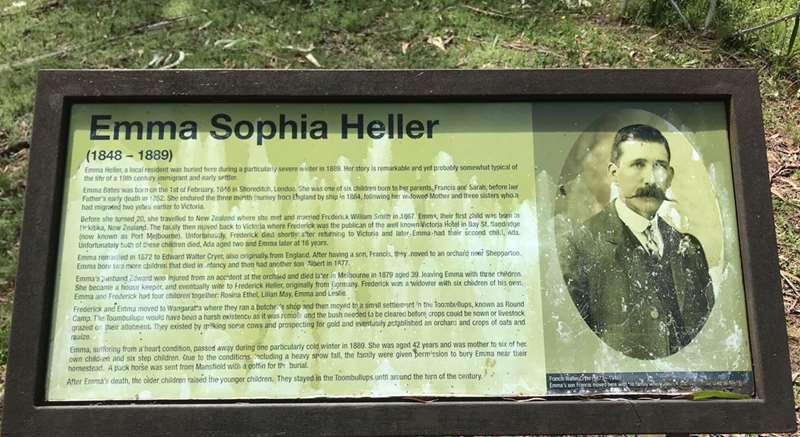Archerton - Stringybark Historical Reserve

Stringybark Historical Reserve is where the infamous shoot out between police and the Kelly Gang took place on 26 October, 1878. The Gang surprised the police at their camp and, in the ensuing gun battle, three policeman were killed. A police memorial has been erected here also a historical walk.

Background
By August 1878, the police realised their search for the Kelly brothers was going nowhere. In addition to horse stealing charges, a 100 pound reward and a warrant for the arrest of Ned Kelly for the attempted murder of Constable Fitzpatrick at Ellen Kelly's hut on 15th April was outstanding. Numerous attempts to find the brothers had not succeeded. They had been laying low in their but on Bullock Creek near here.
In a bid to finally resolve the outstanding warrants and capture the Kellys, a plan was developed for a police party to ride out from Mansfield and to set up a base camp at Stringybark Creek. Here they would scout the surrounding area before joining up with a second police group heading south from the Hedi Police Station. Together the two groups would then form a single party to advance into the prime search area at the head of the King River.
The Mansfield police team comprised Sergeant Kennedy and his colleague Constable McIntyre. They were assisted by two additional police constables brought in specially for the operation. Constable Scanlan also knew the area well and Constable Lonigan from Violet Town knew Kelly. On Friday 25th October the party set off, never dreaming they would be camping that very night within just two miles of the fugitives they were seeking.
Kelly Tree

The Kelly tree is supposedly a historic tree marking the site of the Kelly Gang and police shoot-out. In fact, the tree is on the wrong side of the creek and several hundred metres from the actual location of the historic incident.
On 26th October 1878 a tall gum tree close to Stringybark, Toombullup, was marked by a astray bullet during the shoot-out between the Kelly gang and the police troopers. This tree became known as the Kelly Tree but in 1908 sawmillers cut it down for timber.
A second 'ringbarked' dead tree in the 1920s, selected by landowner Charlie Beasley, was used as a 'fingerboard' sign, only to fall into decay in the 1940s. Finally, Tim Brond, a neighbour of Beasley, marked a forked gum close to the Stringybark Creek and the former tree. This tree became a living memorial to the three police troopers who lost their lives there, with their names carved into the trunk.
In 1985, the tree was officially identified as the Kelly Tree, with a metal plaque representing Kelly's armour replacing the carved names. The tree trunk has grown around the plaque, but the plaque remains visible today.
In 2001, a plaque was placed at the Stringybark Creek Reserve commemorating the deaths of the three police troopers, Sgt Kennedy and Constables Lonigan and Scanlan.
Stringybark Creek Walk

Whilst at the reserve, take in the Stringybark Creek Walk, which is a 1.4 km walking track, taking approximately 30 minutes to complete.
When the unarmed Constable McIntyre seized a momentary chance to jump on Sergeant Kennedy's horse as he tried to control it amidst the surrounding gunfire, the frightened animal bolted into the bush.
In the process it made a new path through the thick undergrowth. Sergeant Kennedy then briefly followed along this makeshift trail before veering off northwest into the bush as he fled the scene chased by Ned and Dan Kelly shortly afterwards.
The Stringybark Creek Walk first sets out on a course that re-enacts the path the two policemen tooks as they escaped from the second ambush.
Constable McIntyre managed to survive his wild ride through the bush. Sergeant Kennedyundertook a fighting retreat before being again shot and later murdered 'a quarter of a mile' [approximately] north west of the police camp.
There is comprehensive interpretive signage located throughout the area.
Directions
The natural bush setting at Stringybark Creek is largely undisturbed and can be reached by a well-graded dirt from Mansfield or Benalla. Caution: logging trucks frequently use this road.
From Benalla take the road to Tatong and follow the signs to Stringybark Creek. This road becomes gravel as you enter the State Forest. The day visitor area is down Stringybark Creek Road and provides picnic and wood barbecue facilities.
From Mansfield take the Mansfield-Whitfield Road for 31km. Turn left down the Tatong-Tolmie Road and travel for approximately ten kilometres. Stringybark Creek Road is on the left hand side.
Access for Dogs:
Dogs are permitted on-leash.
Heller Historic Grave
If heading out to Stringybark Creek, take a slight detour and visit the Heller Historic Grave. It is located on Madhouse Road, Archerton (not far from the Tatong-Tolmie Road).
The grave is a memorial to Emma Sophia Heller (1848 - 1889) who passed away during a severe winter in 1869. Read the interpretive signage and find out all about her remarkable life as a 19th century immigrant and early settler.

Emma Sophia Heller (1848 - 1889)
Emma Heller, a local resident was buried here during a particularly severe winter in 1889. Her story is remarkable and yet probably somewhat typical of the life of a 19th century immigrant and early settler.
Emma Bates was born on the 1st of February, 1848 in Shoreditch, London. She was one of six children born to her parents, Francis and Sarah, before her father's early death in 1852. She endured the three month journey from England by ship in 1864, following her widowed mother and three sisters whom had migrated two years earlier to Victoria.
Before she turned 20, she travelled to New Zealand where she met and married Frederick William Smith in 1867. Emma, their first child was born in Hokitika, New Zealand. The family then moved back to Victoria where Frederick was the publican of the well known Victoria Hotel in Bay St, Sandridge (now known as Port Melbourne). Unfortunately, Frederick died shortly after returning to Victoria and later Emma had their second child, Ada. Unfortunately both of these children died. Ada aged two and Emma later at 16 years.
Emma remarried in 1872 to Edward Walter Cryer, also originally from England. After having a son, Francis, they moved to an orchard near Shepparton. Emma bore two more children that died in infancy and then had another son Albert in 1877.
Emma's husband Edward was injured from an accident at the orchard and died later in Melbourne in 1879 aged 39 leaving Emma with three children. She became a house keeper, and eventually wife to Frederick Heller, originally from Germany. Frederick was a widower with six children of his own. Emma and Frederick had four children together: Rosina Ethel, Lilian May, Emma and Leslie.
Frederick and Emma moved to Wangaratta where they ran a butcher's shop and then moved to a small settlement in the Toombullups, known as Round Camp. The Toombullup, would have been a harsh existence as it was remote and the bush needed to be cleared before crops could be sown or livestock grazed on their allotment. They existed by milking some cows and prospecting for gold and eventually established an orchard and crops of oats and maize.
Emma, suffering from a heart condition, passed away during one particularly cold winter in 1889. She was aged 42 years and was mother to six of her own children and six step children. Due to the conditions, including a heavy snow fall, the family were given permission to bury Emma near their homestead. A pack horse was sent from Mansfield with a coffin for the burial.
After Emma's death, the older children raised the younger children. They stayed in the Toombullups until around the turn of the century.
Location
Kelly Tree Walk, Archerton 3723 View Map








